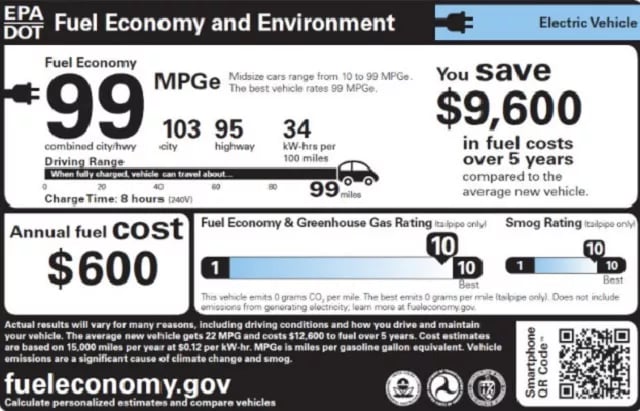Design | Custom Buildings | Renewable Energy
Understanding the Range of Electric Vehicles


Understanding the range of electric (EVs) is an important factor to consider when purchasing one for commercial use. Most drivers today understand miles per gallon, or mpg. This is the standard unit for gas car efficiency. We know a small, lightweight, compact car with a 4-cylinder engine can achieve 30-40 miles per gallon (mpg). When hauling heavy loads or equipment, the fuel efficiency of a large work truck or SUV can be as low as 8-10 mpg. In most instances, we know that if we have to go 100 miles, we are probably safe buying four to five gallons of gasoline before moving on. And gas stations are pretty prevalent should we need to top up.
What's the MPG Equivalent for an EV?
But what if you buy an EV? Charging stations aren't as prevalent yet. Do you know how big the EV's battery is in kilowatt-hours (kWh)? Do you know how efficient the EV is or how many miles it can move per kWh? Luckily, the Environmental Protection Agency (EPA) and Department of Transportation (DOT) have updated the window sticker each dealer must include on new EVs, which answers this question and more.
For efficiency, the EPA displays driving range as the number of kWh used per 100 miles driven. For example, on the sticker pictured, the car uses 34 kWh per 100 miles.

To calculate the range per mile, you would divide:
100 miles ÷ 34 kWh = 2.9411… This car uses 2.94 kWh per mile driven. (This is its efficiency.)
How to Calculate an EV's Range
This image doesn't show the battery size, but an EV for sale will prominently list the battery size. With the battery size and the driving range noted on the EPA sticker, you can estimate the EV's range by multiplying the battery size by the efficiency.
To make the math easy, we'll use 100 kWh for the battery size in this example. That would give this car a range of 294 miles. In 2021, the battery sizes of EVs ranged from around 40 kWh to more than 100 kWh, with the average battery size for new EVs around 60-70 kWh.
It's important to remember that this is an average, just like mpg. Like gasoline cars, an EV's efficiency can decrease when towing or hauling heavy loads, driving uphill, or other conditions that demand more power from the vehicle.
If the driver of the vehicle above pulled up to a DC fast charger, how would they know how much electricity to buy? If they have 50-60 miles left for the day, you can round their car's miles per kWh from 2.94 to 3 and see that they need to buy about 20 kWh. If their EV says the battery is 25% full and they want it to be 75% full, they need to buy 50 kWh, to gain about 150 miles of range.
The EPA's new window sticker also shows useful information like charging time, which tells you how long it will take to charge an empty battery to full using the typical charger sold for home use for EV buyers, a Level 2, 240v charger.
Displayed prominently on the sticker, you'll find the annual fuel cost for this vehicle is $600. The EPA explains that it assumes 15,000 miles per year and a projected electricity price. But below is a comparison of a gasoline car and this EV, assuming 25 mpg for the gasoline car, 12 cents per kWh for at-home, Level 2 charging, and a gasoline price of $3.50 per gallon. (At the time of this writing, the AAA National Average price for gasoline was $3.488, we're rounding up.)
Gas vs Electric Comparison
| Electric Vehicle | Gasoline Vehicle | |
| Miles driven per year | 15,000 | 15,000 |
| Miles per kWh or gallon | 2.94 | 25 |
| kWh or gallons purchased per year | 5,102 | 600 |
| Price per kWh or gallon | $0.12 | $3.50 |
| Yearly fuel cost | $612.24 | $2,100.00 |
This comparison shows how much an EV owner can save by switching from gasoline to electricity, with savings of nearly $1,500 per year. Understanding the range of electric vehicles is crucial for commercial buyers who want to switch to EVs. By knowing an EV's battery size, efficiency, and driving conditions, one can calculate its range and plan trips accordingly.
While the charging infrastructure for EVs is not as prevalent as gasoline stations yet, it is growing rapidly. Understanding the batteries, their capacities, and their range makes it easier than ever to make the switch from gas vehicles to EVs. The cost savings of owning an EV make it a smart choice for both the environment and your wallet. So, next time you're considering a commercial vehicle purchase, remember the benefits of electric vehicles and how understanding their range can help you make the most of your investment.
To help give that charging infrastructure a boost, RedGuard has introduced the ModEV fast charging station. This modular charging station is a game-changer for EV charging infrastructure. It's a container-based unit that can simultaneously charge up to four EVs at 150 kW each. With the added advantage of a battery buffer system, this smart charger can provide 150 kW charging using a much smaller grid connection, making it faster to deploy and hook up than other options. The ModEV also features credit card readers, user interface screens, security cameras, and exterior lighting for added convenience and safety. It can be placed and ready to use in a day.
To learn more, download our informational PDF.
Austin Gillen
Austin has been in Market Development for RedGuard since 2016. His focus is on new and emerging technologies in an effort to diversify RedGuard’s product offerings.


